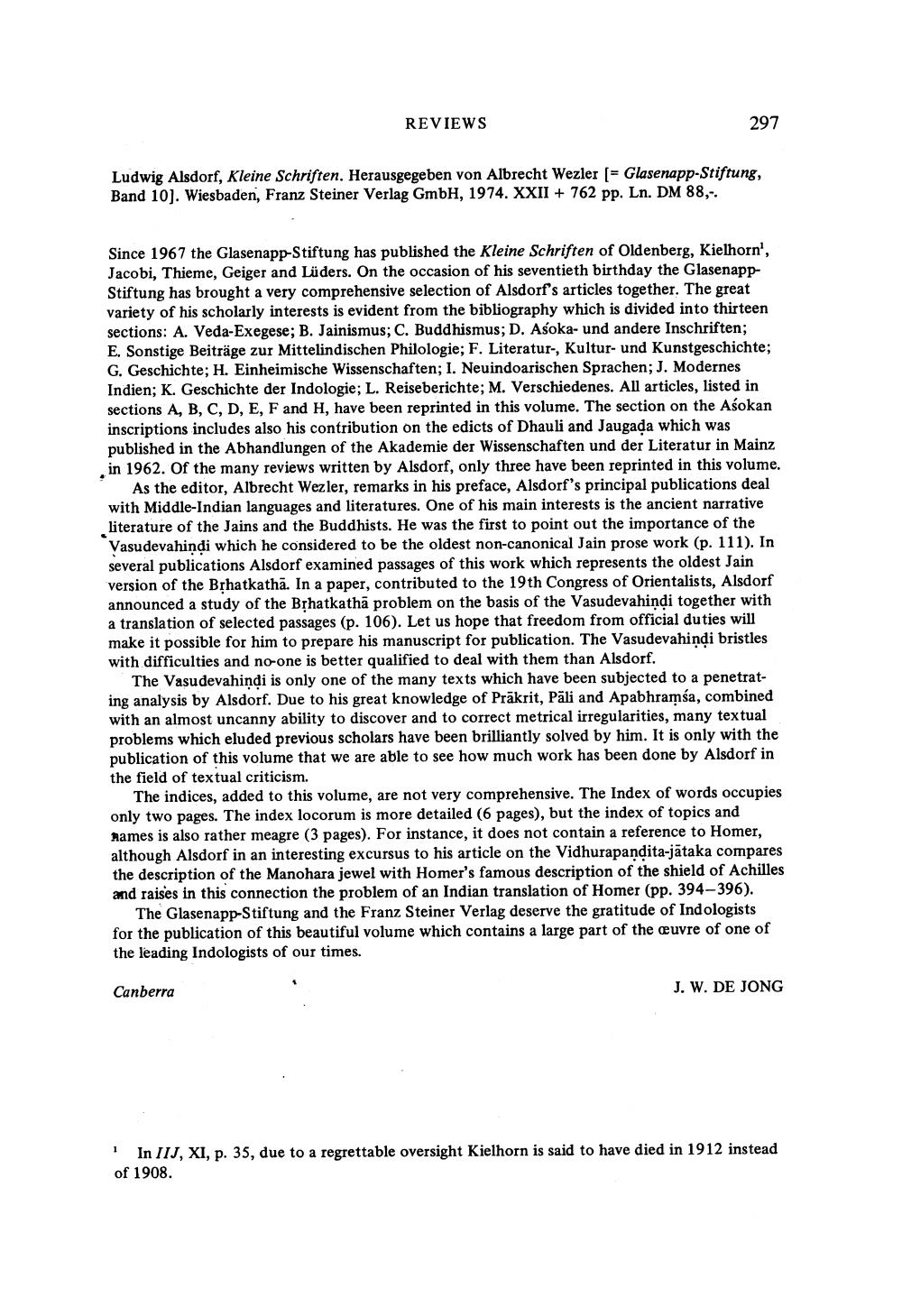Book Title: Reviews Of Different Books Author(s): J W De Jong Publisher: J W De Jong View full book textPage 1
________________ REVIEWS 297 Ludwig Alsdorf, Kleine Schriften. Herausgegeben von Albrecht Wezler (= Glasenapp-Stiftung, Band 10). Wiesbaden, Franz Steiner Verlag GmbH, 1974. XXII + 762 pp. Ln. DM 88, Since 1967 the Glasenapp-Stiftung has published the Kleine Schriften of Oldenberg, Kielhorn', Jacobi, Thieme, Geiger and Lüders. On the occasion of his seventieth birthday the GlasenappStiftung has brought a very comprehensive selection of Alsdorf's articles together. The great variety of his scholarly interests is evident from the bibliography which is divided into thirteen sections: A. Veda-Exegese; B. Jainismus; C. Buddhismus; D. Asoka- und andere inschriften: E. Sonstige Beiträge zur Mittelindischen Philologie; F. Literatur., Kultur- und Kunstgeschichte; G. Geschichte; H. Einheimische Wissenschaften; 1. Neuindoarischen Sprachen; J. Modernes Indien: K. Geschichte der Indologie; L. Reiseberichte; M. Verschiedenes. All articles, listed in sections A, B, C, D, E, F and H, have been reprinted in this volume. The section on the Asokan inscriptions includes also his contribution on the edicts of Dhauli and Jaugada which was published in the Abhandlungen of the Akademie der Wissenschaften und der Literatur in Mainz in 1962. Of the many reviews written by Alsdorf, only three have been reprinted in this volume. As the editor, Albrecht Wezler, remarks in his preface, Alsdorf's principal publications deal with Middle-Indian languages and literatures. One of his main interests is the ancient narrative literature of the Jains and the Buddhists. He was the first to point out the importance of the Vasudevahindi which he considered to be the oldest non-canonical Jain prose work (p. 111). In several publications Alsdorf examined passages of this work which represents the oldest Jain version of the BỊhatkathā. In a paper, contributed to the 19th Congress of Orientalists, Alsdorf announced a study of the Brhatkathā problem on the basis of the Vasudevahindi together with a translation of selected passages (p. 106). Let us hope that freedom from official duties will make it possible for him to prepare his manuscript for publication. The Vasudevahindi bristles with difficulties and no one is better qualified to deal with them than Alsdorf. The Vasudevahindi is only one of the many texts which have been subjected to a penetrating analysis by Alsdorf. Due to his great knowledge of Prākrit, Pāli and Apabhramsa, combined with an almost uncanny ability to discover and to correct metrical irregularities, many textual problems which eluded previous scholars have been brilliantly solved by him. It is only with the publication of this volume that we are able to see how much work has been done by Alsdorf in the field of textual criticism. The indices, added to this volume, are not very comprehensive. The Index of words occupies only two pages. The index locorum is more detailed (6 pages), but the index of topics and names is also rather meagre (3 pages). For instance, it does not contain a reference to Homer, although Alsdorf in an interesting excursus to his article on the Vidhurapandita-jataka compares the description of the Manohara jewel with Homer's famous description of the shield of Achilles and raises in this connection the problem of an Indian translation of Homer (pp. 394-396). The Glasenapp-Stiftung and the Franz Steiner Verlag deserve the gratitude of Indologists for the publication of this beautiful volume which contains a large part of the euvre of one of the leading Indologists of our times. Canberra J. W. DE JONG ! In IIJ, XI, p. 35, due to a regrettable oversight Kielhorn is said to have died in 1912 instead of 1908.Page Navigation
1 2 3 4 5 6 7 8 9 10 11 12 ... 32
